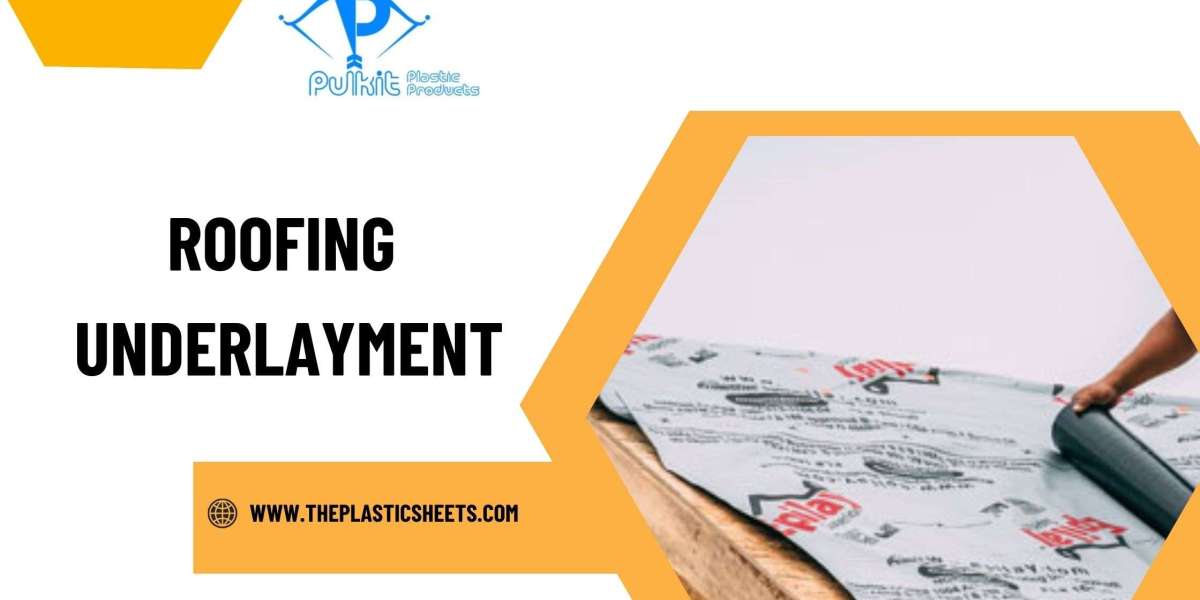When it comes to building or renovating a roof, the first thing that often comes to mind is the visible outer layer — whether it's tiles, metal sheets, or shingles. But there's a critical component underneath that plays a major role in keeping your roof durable and your home safe: roofing underlayment.
In this guide, we’ll walk you through everything you need to know about roofing underlayment, from what it is and why it matters, to how to choose the right one — especially if you're looking for Roof underlayment in India. We’ll also highlight the role of trusted suppliers like Pulkit Plastic Products, a renowned roofing underlayment manufacturer and supplier.
What Is Roofing Underlayment?
Roofing underlayment is a water-resistant or waterproof barrier material that is installed directly onto your roof deck before the final roofing material (like tiles or shingles) is applied. Think of it as your roof’s second line of defense against the elements.
It helps protect the structure of your home from rain, snow, and wind-driven moisture that can sneak past the outer roofing layer.
There are three primary types of roofing underlayment:
Asphalt-saturated felt – Traditional, affordable, and fairly water-resistant.
Synthetic underlayment – Lightweight, durable, and increasingly popular in modern roofing.
Rubberized asphalt – Waterproof and self-adhering, ideal for high-risk areas like valleys or eaves.
Why Roofing Underlayment Matters
Roofing underlayment might not be visible, but its importance cannot be overstated. Here’s why:
Moisture Barrier
Even the most well-installed roof can allow a small amount of moisture to seep in. Underlayment helps protect the roof deck from water damage, rot, and mold.
Extra Protection During Construction
If the final roofing material hasn’t been installed yet and it rains, a good underlayment protects the house in the meantime.
Increased Roof Lifespan
By adding an additional layer of protection, underlayment can extend the overall life of your roof.
Fire Resistance
Some underlayment materials provide an added layer of fire resistance, depending on the fire rating needed for your roof.
Weather Durability
In windy areas, shingles can blow off. The underlayment acts as a safeguard, keeping the elements out even when the top layer is compromised.
Types of Roof Underlayment in India
India’s diverse climate—from monsoons and high humidity to dry heat—makes choosing the right roof underlayment in India especially crucial. Here are some commonly used options:
Synthetic Underlayment
This is the most preferred option today due to its strength, flexibility, and lightweight nature. It performs well in all weather conditions and resists tearing, making it perfect for India’s diverse environments.
Bituminous Underlayment
Often used in regions with heavy rainfall, this type provides waterproof protection and good adhesion to the roof deck.
Felt (Tar Paper)
Still used in many parts of the country due to affordability, though it's being increasingly replaced by synthetic options.
Choosing the Right Roofing Underlayment Manufacturer
The effectiveness of roofing underlayment largely depends on the quality of the product. This is where a reliable Roofing underlayment manufacturer plays a vital role.
Pulkit Plastic Products – A Trusted Name
Pulkit Plastic Products stands out in the Indian market as a high-quality Roofing underlayment supplier and manufacturer. Known for their precision engineering, durable materials, and customer-centric approach, Pulkit offers a range of synthetic underlayment options tailored to Indian climatic conditions.
Their products are:
Weather-resistant and durable
Designed for high tensile strength
Lightweight and easy to install
Environmentally friendly
Customizable for different roofing styles and materials
Whether you are a builder, architect, or homeowner, working with a reputed supplier like Pulkit ensures peace of mind and long-lasting protection.
Key Considerations When Choosing Roofing Underlayment
When selecting underlayment, consider the following:
Climate
If you’re in an area with heavy rainfall or snow (like North or Northeast India), opt for waterproof materials like rubberized asphalt or advanced synthetic sheets.
Roofing Material
Different roofing materials pair better with different underlayments. For example, metal roofs often require specific underlayments that can withstand high temperatures.
Budget
While synthetic underlayments might cost more upfront, they offer better durability and lower maintenance in the long run.
Slope of the Roof
Steeper roofs handle water runoff better, so the underlayment might not need to be as waterproof as on flatter roofs, where water can pool.
Installation Tips
Even the best roofing underlayment won’t perform well if it’s poorly installed. Here are a few basic tips:
Ensure a clean and dry roof deck before installation.
Overlap seams properly to prevent water penetration.
Use cap nails or adhesives recommended by the manufacturer.
Cover the entire roof deck, especially valleys and edges where water accumulation is highest.
Hiring experienced professionals and sourcing from reputable roofing underlayment suppliers like Pulkit Plastic Products ensures quality installation and longevity.
Conclusion
Roofing underlayment might not be visible to the naked eye, but it plays a pivotal role in your roof’s performance and your home’s safety. Whether you're constructing a new home or re-roofing an existing one, understanding the value of this layer can help you make informed decisions.
For those looking for roof underlayment in India, choosing a reliable brand like Pulkit Plastic Products ensures top-notch quality, climate-appropriate materials, and long-lasting protection. Don’t overlook this unsung hero of roofing—because what’s underneath truly matters.
FAQs About Roofing Underlayment
Q1: Is roofing underlayment necessary?
A: Absolutely. While not always legally required, it is highly recommended as it provides an extra layer of protection against water and wind damage.
Q2: How long does roof underlayment last?
A: High-quality synthetic underlayment can last 20–30 years, while traditional felt typically lasts 10–15 years, depending on weather and maintenance.



